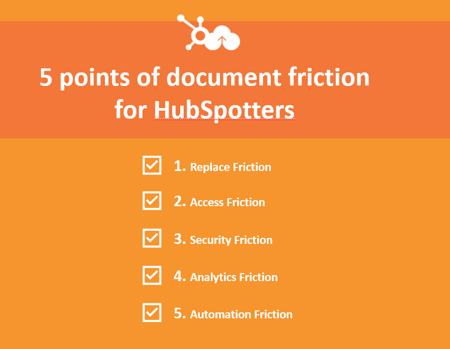 Editor's Note: This is a guest blog by guest blogger Siddharth Garg from CloudFiles.
Editor's Note: This is a guest blog by guest blogger Siddharth Garg from CloudFiles.
Document management plays a crucial role in aligning sales and marketing. Marketing is typically responsible for maintaining a comprehensive content library, including whitepapers, case studies, and other types of collateral. Sales needs daily access to these files. Furthermore, sales and service also have proposals, contracts, and other types of documents that they need to store and maintain. All this requires well-defined processes that add friction to the company's overall revenue operations.
The problem compounds as the company size grows.
HubSpot's File Manager and Documents tool provide out-of-the-box solutions for storing and maintaining files. However, the lack of synchronization with external file sources, such as SharePoint and Google Drive, can lead to friction when a prospect's team is already using one of those platforms. Furthermore, beyond access, there are other aspects of the document lifecycle process, including sharing, automation, and analytics, which are limited in these OOTB tools.
In this article, we will address the five primary friction points that sales and marketing teams using HubSpot typically encounter in document management. We will explain why the OOTB tools do not provide a seamless experience. We will also delve into the various marketplace apps that can aid in reducing these frictions.
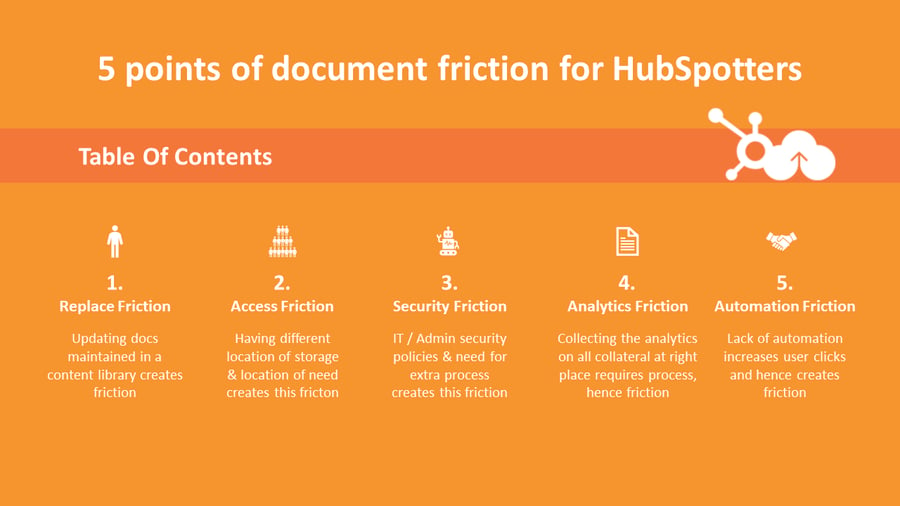
The Replace Friction
Documents update over time. Most sales and marketing teams utilize Microsoft or Google editors, or other contemporary tools, to create or revise their documents. Replacing these documents in the HubSpot File Manager can often result in friction, particularly for the sales and service teams, rather than the marketing team. The same challenge can arise when utilizing one of the sales enablement platforms, such as Seismic, to manage the library.
This highlights that the replacement of documents within the preferred library is a significant friction point for widespread adoption by large sales and service teams. The most straightforward method of mitigating this friction is to allow sales, marketing, and service teams to continue utilizing their current tools, such as Google Drive or locally synced OneDrive/SharePoint.
However, this introduces another friction point, which is how to provide easy access to these external files. For instance, a sales user utilizing Google Drive files would need to access and edit them from within the HubSpot record. At the same time, it is essential to minimize the replacements made by marketing. If frequent replacements are required, the friction on the marketing side can accumulate. We will discuss ways to reduce this friction in the following section.
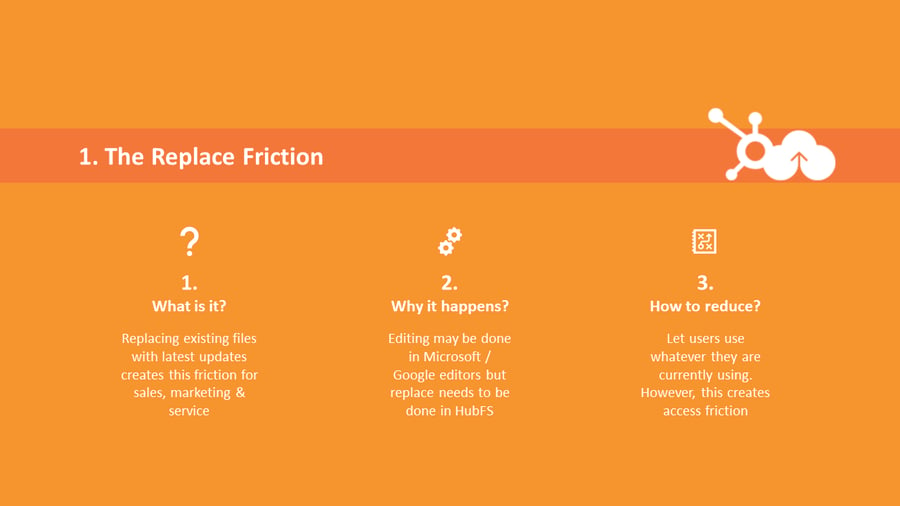
The Access Friction
It is imperative that the content served by both sales and marketing teams is always up-to-date. Marketers serve content on the website, behind form walls, in sales sequences, ads, etc. Meanwhile, sales teams require the latest content when sending emails to advance the deal. This creates friction, as the location where the files are stored and where they are needed may be distinct. For instance, a sales executive may need marketing collateral in their Outlook account, which they use to send emails.
The HubSpot File Manager is highly effective when the place of need and the place of storage are both within HubSpot. Marketers can utilize the HubSpot CMS features and sales sequences to send the latest HubFS files, while sales teams can easily access email attachments directly from the record. Even if the place of need changes to Gmail or Outlook, the HubSpot browser extension can still help minimize friction. Access to the HubSpot File Manager can be achieved through the extension in your email client.
However, friction arises when the place of storage changes, regardless of the place of need. If files are needed on CMS or HubSpot records, they must be manually downloaded and uploaded. Tools such as Zapier can assist in copying cloud storage links (e.g., a link to a Google Drive folder assigned to a deal) to HubSpot properties, reducing this friction to some extent. Another option is CloudFiles, a more deeply integrated tool that can accomplish this.
If both the place of need and storage are not within HubSpot, the friction increases exponentially. A service executive may require access to a Google Drive folder connected to a HubSpot contact from Gmail, or a marketer may need access to a whitepaper in SharePoint for a LinkedIn outbound campaign, so that the open analytics can be pushed to HubSpot. Tools such as CloudFiles can offer some assistance here, with the promise of Gmail and Outlook extensions. However, the problem is still not fully resolved.
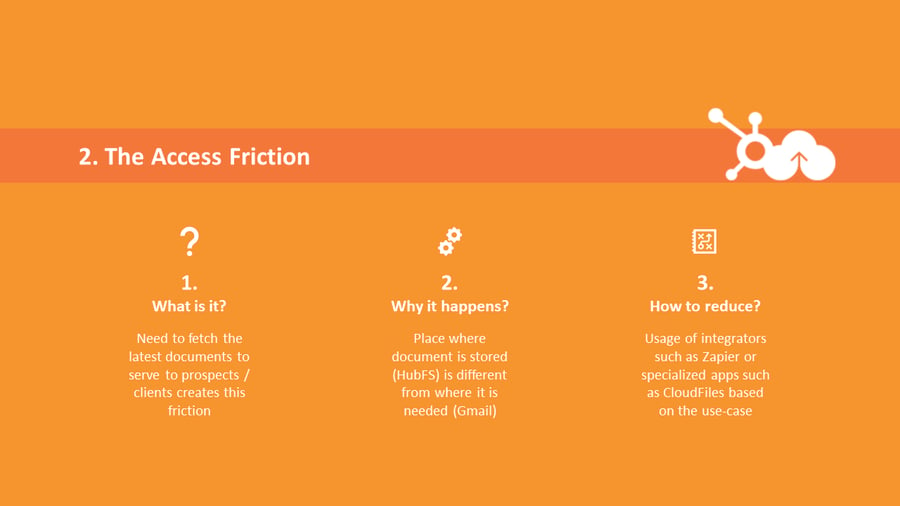
The Security Friction
The demands of IT teams and administration for security on internal and shared files can add friction to the sales and marketing processes. These demands may include the encryption of email attachments or expiring links on SharePoint, and may apply to specific or all sales and marketing collateral.
The friction may take the form of additional steps required for sharing, or a sub-par viewing experience for customers. For example, sharing links from SharePoint may require circulating an internal library of links stored in an Excel sheet, adding another layer of friction. Similarly, customers may be required to log into Google or Outlook to access documents, causing friction on their end.
Tools like Zapier can provide quick access to these links through automations, but they still limit security settings to those provided by Microsoft or Google. Additionally, this does not solve the customer experience problems that can pose a challenge for marketing.
Specialized document sharing tools such as CloudFiles or DocSend can help address this friction. These tools offer viewer capabilities, allowing any type of file to be rendered in the browser, and enabling their own security settings on the viewing links. For example, CloudFiles can restrict access to free email providers for marketers, as well as require domain-agnostic email authentication for sales on a live Google doc. With its own viewer, it provides a smooth performance and a branded viewing experience.
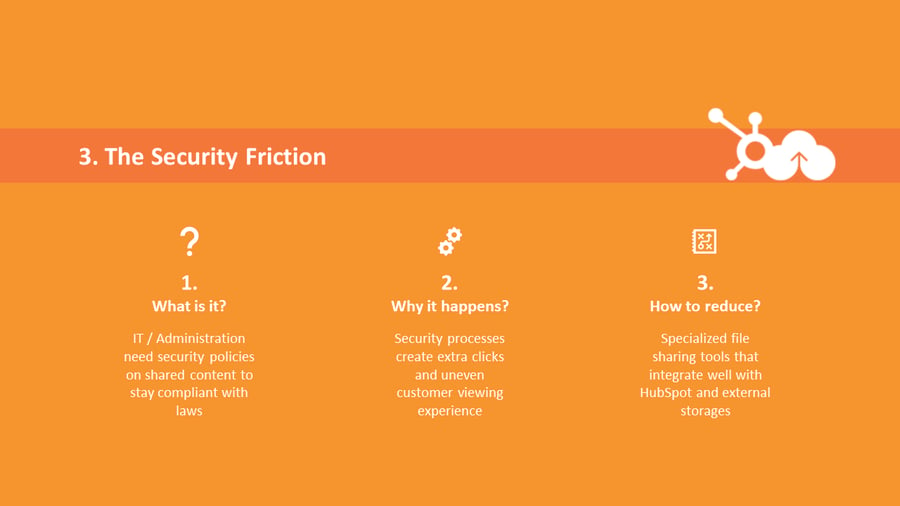
The Analytics Friction
Sales and marketing teams love analytics. Document analytics can include information such as the number of opens, sessions, scroll depth, and time spent on pages. However, gathering this data in a centralized location for all shared collateral is a challenge and requires special tools, which adds friction for all teams.
For marketers, the friction lies in collecting and utilizing the analytics from the tool. For example, the HubSpot professional version offers unlimited HubSpot documents, which is a tool specifically designed for analytics. However, having sales teams use this tool creates too much friction in terms of access. Additionally, for the analytics to be useful, they must be accessible in lists, reports, and workflows. Without this, there is friction in terms of consumption.
For sales, the friction arises from the tool's integrability with HubSpot. The tool should not add clicks to their current process and the analytics must be available in the right place (e.g., on the record timeline) so that they can follow up efficiently.
While tools like HubSpot Documents and DocSend offer solutions, CloudFiles stands out for this purpose. The tool collects analytics for all types of files and integrates with HubFS and other major cloud storage systems, which minimizes the friction related to replacement, access, and security that was covered earlier. With an upcoming Gmail/Outlook extension, it can also make the analytics accessible in email clients.
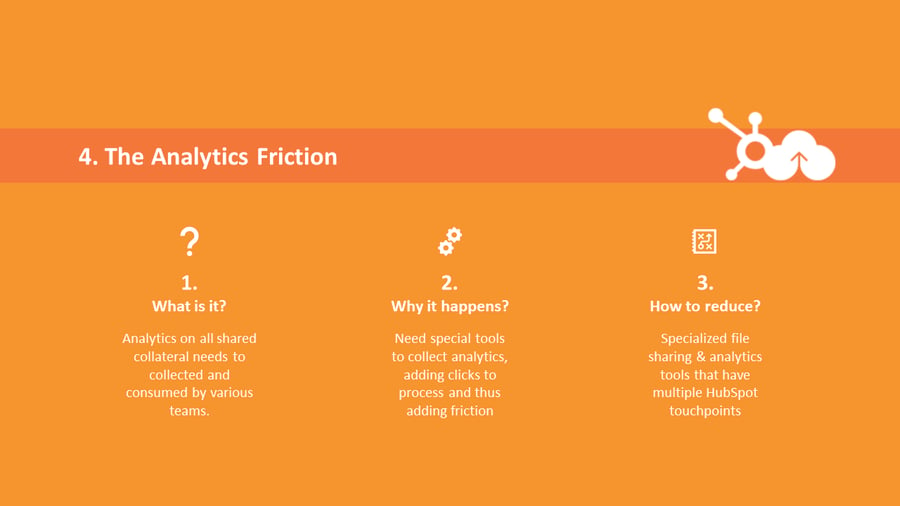
The Automation Friction
Automation is crucial when processes are well-defined and teams are large. Marketing teams might require the implementation of complex email funnels based on white paper engagement, or the promotion of the most engaged MQLs to the top for the sales team to follow up. Sales teams may need Google folders set up for deals when they are created. The lack of automation results in additional clicks and creates friction.
Tools such as Zapier can provide assistance, but their integration into HubSpot is limited. For example, Zapier can create a folder in SharePoint when a deal is created and post its link on a HubSpot property, but it lacks engagement data and UI to make complex automations possible.
CloudFiles offers specialized automation capabilities through the use of workflow triggers, list filters, and workflow actions. These are highly modular, making it possible to set up complex automations. For instance, using the app, a marketer can segment all the people who scrolled halfway through a document and send an internal notification to sales when the prospect views the document again. Sales can easily create complex folder hierarchies and associate them with records using HubSpot workflows.
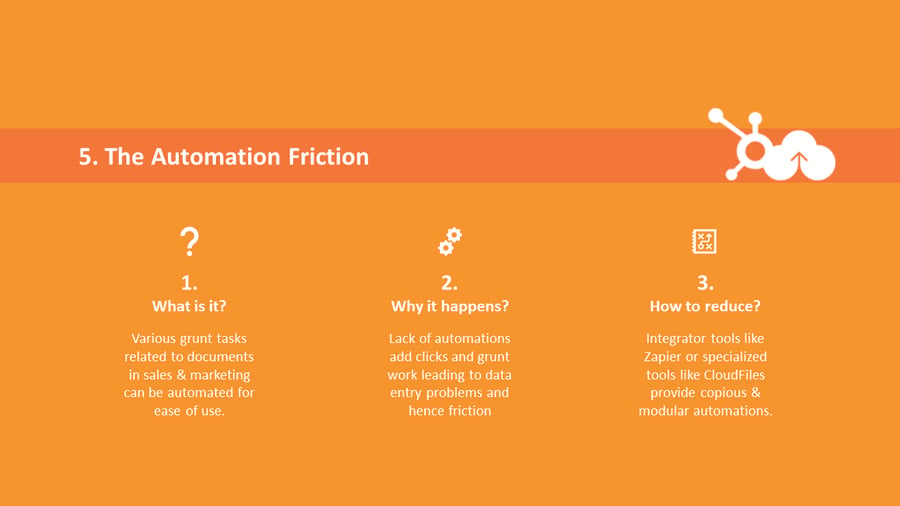
To Sum it Up
In this article, we discussed five key friction points that arise in document-heavy scenarios between sales and marketing teams. We found that while the HubSpot File Manager and HubSpot Documents can address some of these issues, external integrations may be necessary for further optimization.
For simple connection requirements, tools like Zapier may be adequate. However, for more intricate scenarios involving sharing, analytics, and advanced automations, a more integrated solution like CloudFiles may be the optimal choice.
About The Author
 Siddharth Garg
Siddharth Garg
Siddharth is the co-founder & head of growth at CloudFiles. He loves reading epic fictions, eating great food and talking about quantum physics. He also loves providing great customer service.

